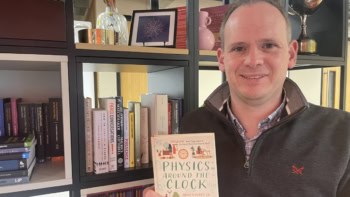This year marks the 150th anniversary of Dmitri Mendeleev creating the world’s periodic table and we’re celebrating this iconic graphic with the cover feature of the February 2019 issue of Physics World magazine.
In the article, Robert P Crease examines the events that led to Mendeleev creating that first table – and traces how it developed over the decades that followed. Turns out, there have been hundreds of different versions – and the one we know and love today bears little resemblance to Mendeleev’s primitive early version.

Elsewhere in the issue, you can find out about the strange interstellar object ‘Oumuamua – is it comet or asteroid? – and explore the science of materials that can power a car and structure it too.
You can enjoy the January 2019 issue of Physics World magazine via our digital apps for iOS, Android and Web browsers. (membership of the Institute of Physics required). Let us know what you think about the issue on Twitter, Facebook or by e-mailing us at pwld@iop.org.
For the record, here’s a run-down of what’s in the issue.
• Physicists await ILC decision – Japanese particle physicists are hoping that the government will give the green light to the International Linear Collider next month. But as Michael Banks reports, they may be disappointed
• Europe unveils successor to the Large Hadron Collider – A CERN blueprint calls for the construction of a huge 100 km circular collider that would smash together electrons with positrons to study the Higgs boson in unprecedented detail, as Michael Banks reports
• China makes historic Moon landing – With Chang’e-4, China is the first nation to land a craft on the far side of the Moon, as Ling Xin reports
• Modernizing classical physics – David Nolte says it is time to bring the undergraduate physics curriculum into the 21st century
• Innovation, innovation – A year after his first Transactions column, James McKenzie reflects on how to get more physicists to embrace business challenges
• An unelementary affair – More than a thousand different versions of the periodic table have been created since Dmitri Mendeleev drew the first 150 years ago – but why is one version more familiar to us than practically every other? Robert P Crease finds out
• Structural supercapacitors – Energy-storage devices that perform multiple functions, such as powering a vehicle and letting it withstand mechanical loads, offer several potential benefits, as Natasha Shirshova explains
• Visitor from another star – Asteroid, comet, alien ship or something else altogether? Astronomers are still unsure about the true nature of ‘Oumuamua – the first confirmed interstellar object to be detected in our solar system – as Andrew Glester finds out
• Pathway to Pluto – Louisa Preston reviews Chasing New Horizons: Inside the Epic First Mission to Pluto by Alan Stern and David Grinspoon
• Quantum tea and toast – Tushna Commissariat reviews Breakfast with Einstein: the Exotic Physics of Everyday Objects by Chad Orzel
• With stars in my eyes – Tushna Commisariat reviews Seeing Stars: a Complete Guide to the 88 Constellations by Sara Gillingham
• Taking photonics into the future – Hugo Thienpoint talks to Anna Demming about the importance of collaboration for the continued success of the photonics sector
• Once a physicist – Meet Will Foxall, a creative technologist for the South West Creative Technology Network, based at the Watershed in Bristol, UK
• The physics of a youth hostel – Richard Hollins describes how his physics background helped him hen serving as a volunteer helping to run youth hostels in north Wales.



